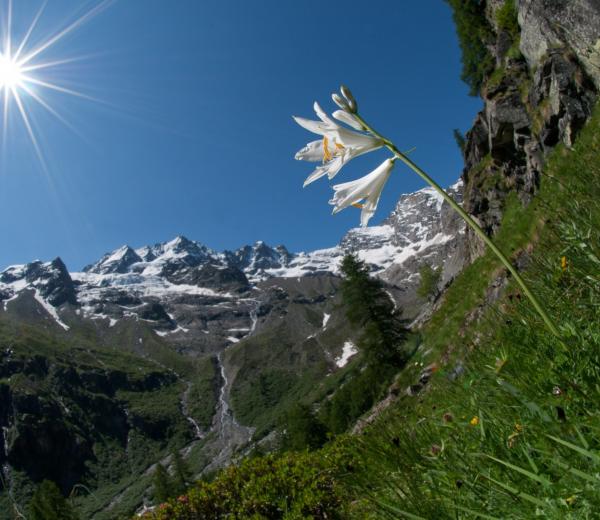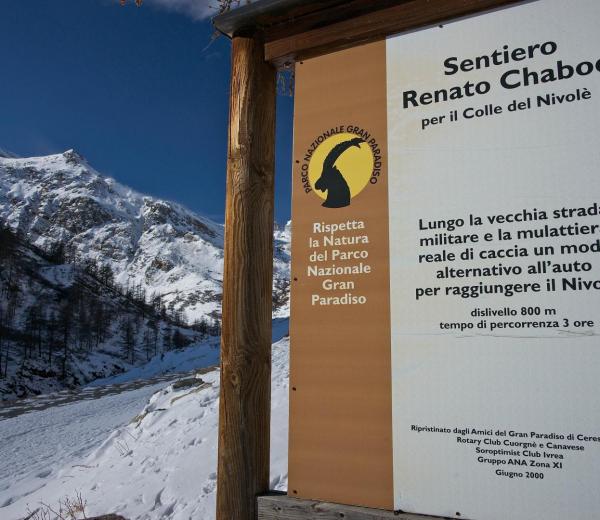1 – What is a protected area?
It is a territory with significant natural and environmental value, that is protected and managed in order to preserve it for present and future generations. When you enter a protected area you are a guest of nature: bring waste back to the valley when returning from excursions, do not pick flowers, insects and minerals that belong to the Park’s natural habitats, do not leave tracks of your passage. (Regulation for the tourist use of the Park)
2 – Where is the Park entrance? How much do I pay?
The borders of the Park are not fenced: the five Park valleys can be visited free-of-charge (obviously in compliance with existing regulations) at any time and there is no entry ticket! Within the Park, you will be able to take excursions with Interpreters, walk along paths or visit the Paradisia Alpine Botanic Garden, the Copper Ecomuseum in Ronco and the Visitors’ Centres.
3 – Where can I see animals?
The Park area extends over more than 173,000 acres, though it is not a zoo, observing animals is quite easy! Wildlife can be seen already at the bottom of the valleys in winter and in spring, while in summer they move high to feed and arrive very well nourished to face the long winter they're expecting. Do not disturb them during this activity, so important for their survival in winter: observe them from a distance.
4 – Why am I not able to take my dog in the Park?
Dogs can be walked on leads only in the areas at the bottom of the valleys and, from the 15th July to the 15th september, along some paths in compliance with the Park's Regulations. Dogs cannot move freely in the Park, since they might meet wildlife that, though not directly attacked by the animal, might be subject to serious stress. The main reason for this limitation is that our dogs are carriers of many diseases dangerous for wildlife, some of these are zoonoses, so diseases with which animals can infect humans.
5 – Can I feed wild animals?
Volpi, marmotte, stambecchi, camosci ecc. non devono ricevere il nostro aiuto, se non in particolari circostanze, pur se questo possa essere considerato un gesto di bontà nei loro confronti. Gli animali selvatici potrebbero infatti reagire, involontariamente, anche in modo aggressivo o comunque abituarsi alla presenza dell’uomo, perdendo così l’istinto e la capacità di procurarsi il cibo, e trasgredendo alle regole della selezione naturale. Non cercate quindi di avvicinarli, ma osservateli da lontano, così potranno mangiare tranquilli!
Foxes, marmots, ibex, chamois etc. must not receive your help, except in particular circumstances, though this might be considered as a generous gesture to them. Wild animals could react, involuntarily, also aggressively or, in any case, get used to the presence of man, thus losing their instinct and ability to find food, and breaking the rules of natural selection. Do not try to get close to them, but observe them from far away, so that they can eat undisturbed!
6 – I would like to work for the Park, how can I?
The Park is a government-controlled institution, the access to jobs vacancies happens by means of a public competition; we suggest you to check in the URP section if there are selections under way. For collaboration offers, instead, contact the specific services, for applications to volunteer activity and internship experiences, refer to the relevant sections in the website.
7 – Where can I camp in the Park?
Animals are sensitive to the presence of man. If people camp where they want, they disturb wildlife, damage pastures, favour the spread of waste. If you want to sleep in a tent in the Park you are welcome, as long as you use the specific campsites. Camping freely outside equipped areas is instead forbidden, for emergency reasons Alpine bivouac for just one night is allowed if there are no shelters in the area or they are full. Also caravans and campers must be parked in campsites or in the specific equipped areas. (Regulation for the tourist use of the Park, Art.10).
8 – Is it true that constructions are forbidden in the Park area? What if I need to do works on my house?
Authorization from the Park Management is necessary for each building activity, work or manufacture in the Park area, under law 394/1991, that must be issued in maximum 60 days (with just one possible extension of 30 days). The procedures described in URP section must therefore be complied with. (How to obtain the issuance of building authorization).
9 - Wild boars damaged my property, how can I be reimbursed?
In the event of damage caused by wildlife to owned property in the Park area, an application for damage must be submitted to the valley offices of the competent surveillance service within 10 days from noticing damage to cultivations. If damage has affected domestic animals, in compliance with summer pasture rules of farmers, it is necessary to apply to the relevant Local Health Unit veterinary and the staff of the surveillance service of the relevant valley office within one day from the predation, and then submit a claim for damage within 20 days.

